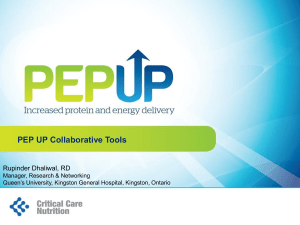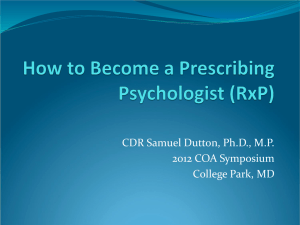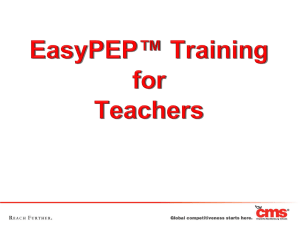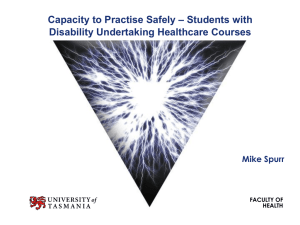PEPs - Haringey LSCB
advertisement
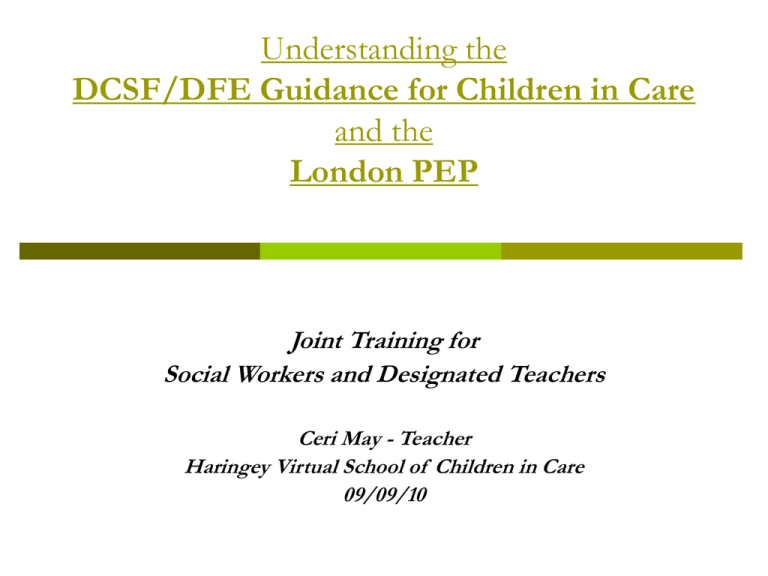
Understanding the DCSF/DFE Guidance for Children in Care and the London PEP Joint Training for Social Workers and Designated Teachers Ceri May - Teacher Haringey Virtual School of Children in Care 09/09/10 Key Educational Messages from Government: Personal Education Plans (PEPs) are more important than ever. The ‘Designated Teacher’ must have qualified teacher status. Additional school-based support should be put in place so that the Child in Care (CiC) succeeds. A CiC should access additional school-based support even if they do not meet the criteria. New Ofsted Criteria have limiting judgements on CiC. High Ofsted focus on Vulnerable Groups. Haringey Initiatives to Reflect Government Policy: Adopt the London PEP: Live on Framework I– Spring Term. Advice to SWs and DTs from Haringey Virtual School. 4 Training Strands: DFE Guidance and the London PEP – joint training to Designated Teachers and Social Workers. DFE Guidance – to Headteacher, School Governor and Designated Teacher. Understanding different attachment styles to improve the quality of teaching and learning. CiC Education Conference & Akamas online learning. Role of the Designated Teacher Lead responsibility within the school for the development and implementation of the PEP. Lead responsibility for helping school staff understand the world of a child in care. Promoting a school culture of: High expectation for children in care. Understanding the emotional, psychological, and social effects of being in care. Adults treating ‘care status’ issues with sensitivity. Individual planning for children in care where the Personal Education Plan (PEP) is central in creating a shared understanding of educational needs. Adults understanding on a ‘needs to know’ basis of how the PEP fits into wider care planning. Role of the Designated Teacher The Designated Teacher should: Contribute to the development and review of whole school policies/procedures to ensure that looked after children are promoted at all times. Lead the process of target setting and promote a culture so that looked after children are involved in their learning goals. Be a source of advice for teachers at school about differentiated teaching strategies appropriate for individual pupils and make sure the school makes full use of ‘Assessment for Learning’. Make sure that looked after children are prioritised for school-based interventions, including ‘Making Good Progress 121 tuition’, even when they do not meet the criteria, and challenge where this is not happening. Promote good home school links and help school staff understand the particular needs of carers in the school setting. Role of the Social Worker To promptly inform the school of anything around the child’s care that could impact on their emotional well-being, behaviour, or ability to concentrate, including: Initial move into care. Change of care placement. Any disruption or instability in care placement. Contact arrangements with birth family - dates. Changes to contact arrangements with birth family. Any court proceedings that could cause anxiety. To initiate the PEP within the statutory timeframe (2 in one academic year) and meet with school staff to set educational targets and share information. The London PEP promotes PEP meetings held in October & March. Role of the Social Worker To share care information with the Designated Teacher and relevant school staff via the PEP, including: What care order the child is under. Who has Parental Responsibility – who signs permissions. Any specific issues around contact at school with birth family members. Any health information. Any confidential information that could impact on the child’s learning, behaviour, social or emotional development at school on a ‘needs to know’ basis. To be a champion for the children in care and ensure that: the adults supporting the child at school and home have high expectations for rapid educational progress. The child is receiving school-based interventions, including Government funded ‘Making Good Progress 121 tuition’. Personal Education Plans (PEPs): Every Child in Care on roll must have a working PEP within the statutory timeframe. A copy of the PEP must be held both at the school and within the Local Authority database. PEPs should set high expectations of rapid progress. The PEP is a living document to be ‘fed’ by ALL. Statutory Timeframe: Within 20 working days of being taken into care. Then 3 months. 6 monthly thereafter. A PEP should be called outside this timeframe if there is a change of care or educational placement, or if there are any concerns that impact on education. PEP Function: The PEP serves as a ‘collective memory’ about the child’s educational history and achievements. Ownership of the PEP is shared between the school and local authority which looks after the child. It is a record of achievement (academic and wider) and a celebration for the young person. It is a key tool for the DT to work with other teachers. To capture the assessed learning needs. To agree challenging targets. To record specific interventions and targeted support to ensure that personal targets are met. To record clear accountability on who does what. London PEP Structure 4 Sections: Section A – Social Worker completes before the meeting, taking multiple hard copies to the school. Section B – Designated Teacher completes before the meeting. Section C – Child / Young Person completes with an adult who is close to their education and knows their learning needs, strengths, weaknesses and aspirations well. Section D – to be completed at the PEP meeting by the DT. It is a ‘Word’ document; so schools will hold sections B,C and D electronically. Section A will be embedded in Framework I; SW holds Section A. Section D is completed at the meeting. The DT passes on the completed sections B,C & D to the SW asap following meeting. SW uploads PEP onto FWi and distributes to all parties. Activity: Use the 4 slides on PEPs in your pack. Make sure you’re a mixed group of SWs & DTs Create a venn diagram – DT SW Name 3 things the SW should contribute to produce a joint quality PEP. Name 3 things the DT should contribute to produce a joint quality PEP. Name 3 things that DT & SW do together to form a quality PEP. Nominate a person to feed back to the group PEP Completion: It is important that the DT, or another teacher with appropriate experience of target-setting writes the educational targets in section D to ensure that they are relevant and appropriately differentiated. The PEP needs to be ‘actioned’ by school staff from the date of the meeting. The PEP (sections A,B,C & D) needs to be uploaded to Framework I by the SW asap. The complete PEP is distributed by the Social Worker. The SW provides the IRO with a copy of the completed PEP 3 days before the LAC Review. Creating a Strong Team Around the Child Guiding Principles: Recognise that the PEP is a vital part of the child’s wider care plan. DT makes sure there is a central point of contact within school. Social Worker shares care information promptly. Social Worker actively seeks out Educational information from the school. School has strong internal communication systems to share information. All parties use plain English, where possible, to communicate information to colleagues from other agencies. School has agreed processes to support the work with colleagues from other agencies and to build relationships. Understanding by ALL that children experiencing strong emotions can impact on the ‘Team around the child’ resulting in the team subconsciously replicating ‘birth family’ patterns of behaviour. Designated Teacher’s Involvement in the Care Planning Process: ‘At the table’ fulfilling the role of ‘Education Champion’. Finding ways to make sure that the latest information about educational progress, primarily through the PEP, is fed into the LAC Statutory Review. Providing advice about the impact of disrupting education. Ensuring that records move promptly to the new school, if a CiC moves school. Ofsted Inspection Framework for Schools from 1 Sept ’09: Outcomes for individuals & groups of pupils, capacity for sustained improvement and overall effectiveness. While on site, inspectors will ‘track’ vulnerable pupils, especially looked after children. Specific attention to quality of learning for specific groups in separate provision & mainstream lessons. One child in care on a school roll constitutes a group. Ofsted Inspection of Safeguarding & Looked After Childrens Services: Will focus on, among other things: Outcomes achieved Access to and attendance at suitable schools The quality of care planning, review and support, including in relation to PEPs Inspections on LAC subject to limiting judgements: Overall effectiveness likely to be inadequate if any outcome judgement inadequate. Overall effectiveness unlikely to be good if ‘enjoying & achieving’ is not judged good. ‘Enjoying & achieving’ not likely to be good if LAC are not making at least good educational progress. Contact Details: Ceri May – Teacher Haringey Virtual School. ceri.may@haringey.gov.uk Tel: 020 8489 3160 Good luck in your roles supporting Children in Care

